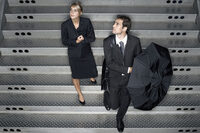 Last year, 609,000 injuries occurred at work according to the Labour Force Survey. Of those, the majority were as a result of a slip, trip or fall.
Last year, 609,000 injuries occurred at work according to the Labour Force Survey. Of those, the majority were as a result of a slip, trip or fall.
The cost to businesses is over £14billion a year and 31.2 million working days lost. The irony is that slip and trip accidents are some of the most easily avoided accidents. Whether you're a business owner or a local authority, managing your site and securing it against staff and visitors suffering accidents requires vigilance, strong processes and the right flooring materials.
Here are some of the key considerations to reduce the risk of slips, trips and falls in the workplace.
Inspections
Make sure you undertake regular inspections of your site to ensure that any defects or hazards are noted and addressed. You might have to hire a safety manager if your workplace is intrinsically dangerous, or train managers or others to monitor the workplace for dangers. You should also make sure your employees know what to do if they encounter a potential hazard.
Clearly mark all potentially dangerous areas with signage. This keeps hazards that might go unnoticed in the front of people's minds. People are more aware of where they put their feet when they see a 'Watch Your Step' sign.
Once you've identified the risks on your site, formulate plans to help employees avoid injury for each risk. Break apart the risks as part of a risk assessment and make a clear and logical list of all steps they must take to avoid harm. This may sound basic and self-evident, but you'd be surprised at the number of businesses that ignore such steps, especially those in low-risk environments such as offices. Remember: accidents can happen anywhere.
Flooring
Once you have established the nature of the potential hazards you have to mitigate, you can choose the right flooring to ensure safety.
If your site is largely outdoors, you should consider a material that is weather resistant and remains slip resistant even when wet. If you need to consider aesthetics, anti-slip flooring panels provide a discrete solution that can blend in with the natural environment so as to be not too visually disruptive. Dangerous locations, such as roof walkways and catwalks on industrial sites often require a lightweight, yet robust solution to allow people to access certain areas without collapsing.
If your site is largely internal, you should make sure your flooring is fit for purpose. If you have trolleys or carts wheeling around, carpet, for all its softness and rugged, easy to clean qualities, isn't the best solution. Areas where different flooring types meet should be highlighted as a tripping hazard, so use threshold bars to create a smooth transition.
Once you've installed your flooring, be mindful of regular inspections. Some flooring, such as stone or wood can be easily damaged and create hazards at any time.
Lighting
Avoiding hazards is easy when you can see them. That's why you should be taking into account what's hanging from your ceiling as much as what's lurking on the floor. Adequate lighting in indoor corridors, stairwells and windowless areas will help keep hazards to a minimum.
Outdoors, lights along walkways allow people to watch out for hazards, as well as promoting security at night time. Adequate lighting also allows visitors and staff to spot differences in flooring levels.
Stairways
Both interior and exterior stairs are common tripping hazards. Trips and slips going downstairs lead to much more dangerous falls which can lead to a significant injury and liability. Consider reinforcing your existing stairs with stair nosings to create a rugged and non-slip strip on the edge of each stair to reinforce the surface. This will reduce the risk of slipping or falling downstairs.
Entrances
High foot traffic areas like entrance ways that are fitted with anti-slip panels or pads reduce the risk of a slip or trip. At high traffic areas, it is important to use a hard-wearing solution in order to remain cost-effective.
Anti-slip panels manufactured from glass reinforced plastic, together with an aluminium oxide diamond hard grit, you can be sure of safety underfoot. They can be screwed, bolted or bonded onto a variety of surfaces including wood, concrete, steel, chequer plate and open gratings.
Having the right materials in the right places is a simple way to reduce the risk of slips or trips in the workplace. After completing a full risk assessment, you'll know exactly what measures you need to take to reduce the risk of slips and trips in hazardous or high traffic areas.
Produced in association with GripClad, UK’s leading supplier of quality anti-slip flooring and stairs safety solutions.